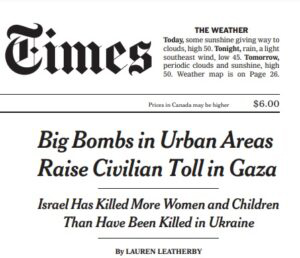|
Getting your Trinity Audio player ready...
|
By: Gilead Ini
Even if civilian casualties during urban warfare are inevitable, this painful truth doesn’t diminish the tragedy of innocent lives lost.
Nor does any other truth. One can speak honestly — about both the context and the impact of fighting in Gaza —without detracting from the human suffering involved. Which raises the question: Why does the New York Times choose to prevaricate on the subject?
In a front-page, above-the-fold story two Sundays ago, the paper relied on omissions, distortions, outright falsehoods — and a blood-soaked terrorist organization — to tell its story about Palestinian casualties in the war that began on Oct. 7.
That was the day Hamas terrorists invaded Israel, slaughtering its residents in the worst massacre of innocent Jews since the Holocaust. The New York Times story seems meant to reverse that narrative, casting Israel as the most arbitrarily violent force, not only in this conflict but in all the world.
In the service of its narrative, the paper misquotes US officials, misrepresents casualty statistics from other global conflicts, and deflects from the fact that their article hinges on data from an arm of the Hamas regime.
Erring From the Start
At essence, the New York Times story takes Hamas claims about the number of women and children killed in Gaza, uses those figures as a stand in for civilian casualties, and compares them to other global conflicts.
The dishonesty accompanying this endeavor begins immediately. “Israel has killed more women and children than have been killed in Ukraine,” announces the subhead in the print edition.
The New York Times states this as fact. But it has no way of knowing whether it is true (and it almost certainly is not). The charge rests not only on credulous acceptance of Hamas claims, but also on a rejection of Ukrainian assessments and UN caveats about that country’s casualty count.
Hamas, whose casualty breakdown is at the core of the subhead (and the article that follows) aren’t just murderers, kidnappers, and rapists. They are, surprising as it may be, dishonest murderers, kidnappers, and rapists. The group has willfully deceived about the fighting since the war began. On Oct. 9, for example, a senior Hamas official insisted his group did not kill “any civilians.” Even a month later, officials stuck to that absurd line. The Hamas health ministry lied when alleging an Israeli airstrike hit Al-Ahli Arab Hospital. It lied when claiming 500 people were killed in that explosion. And yet the Times, despite being so recently duped by the regime about the hospital, insists we should believe that same ministry when calculating numbers of civilian casualties.

It gets worse. About Ukraine’s casualties, the Times relies on United Nations data that counts approximately 10,000 “verified” civilian deaths in Ukraine, some significant portion of whom are women and children. But Ukraine’s chief war crimes prosecutor has spoken of ten times that number of civilians killed. In the Independent, he is quoted saying that “there could be 100,000 civilians killed” in Ukraine, while the reporter who interviewed him described that figure as “the true number by Ukrainian estimates.”
Even if we put aside the prosecutor’s assessment and look only at the newspaper’s source, the UN, it remains true that the Times is clueless on how many Ukrainian women and children have been killed. The UN clearly explains that the actual number of civilian casualties in Ukraine is “considerably higher” than those 10,000 it verified. The newspaper’s subhead, in other words, dishonestly compares an unverified claim to an incomplete count.
As does the body of the article. In print and in earlier online versions, author Lauren Leatherby falsely insists that “[m]ore than twice as many women and children have already been reported killed in Gaza than in Ukraine after almost two years of Russian attacks, according to United Nations estimates.”
After over 24 hours of exposing readers to this falsehood, the paper quietly changed the online language to instead compare those “reported killed in Gaza” with those “confirmed killed in Ukraine.” In parentheses, the paper tacked-on what amounts to an admission that the comparison is meaningless: “The United Nations believes the true toll in Ukraine is considerably higher, however, and Ukrainian officials have estimated that more than 20,000 civilians died in the port city of Mariupol.”
No correction in the print edition has alerted readers to the fact they were misinformed. And no correction online acknowledges the consequential changes made there.
Another Distorted Comparison
This isn’t the only time the article misleads with comparative statistics.
As with its Ukraine analogy, the paper plays games when comparing Gaza casualties with those in Iraq in 2003. “More women and children have been reported killed in Gaza in less than two months than the roughly 7,700 civilians documented as killed by U.S. forces and their international allies in the entire first year of the invasion of Iraq in 2003,” the reporter states, citing estimates from a group called Iraq Body Count.
Israel’s fight against Hamas, readers are meant to believe, is so much more destructive than US operations in Iraq that it squeezed a year’s worth of casualties into a few weeks.
But the statistic is specious. The newspaper’s own source, Iraq Body Count, makes clear that an overwhelming majority of civilian deaths in the Iraq campaign occurred in just weeks of fighting. (Download the relevant spreadsheet data from IBC.)
Indeed, it was only three weeks after the US-led invasion that “[t]he murderous reign of Saddam Hussein effectively ended,” as a New York Times editorial put it. Major combat operations ended shortly thereafter. The number of civilians killed in the first month of fighting in Iraq, in other words, is essentially equal to the number of women and children Hamas claims were killed in the first month of fighting in Gaza.
The New York Times, then, misled readers about Ukraine and Iraq, two of the four examples they contrasted with the Gaza war, so as to wildly exaggerate the differences.
Hamas’s Credibility
And then there’s the Gaza side of the ledger.
In October, after the New York Times ran with inaccurate claims about the Al-Ahli Arab Hospital — the paper trumpeted Hamas’s charge that Israel killed 500 people at the hospital, though it was a misfired Palestinian rocket that struck the hospital’s parking lot, killing a fraction of the claimed number — the newspaper acknowledged its failure. Coverage had “relied too heavily on claims by Hamas,” an Editors’ Note explained, “and did not make clear that those claims could not immediately be verified.” As a result, readers were left with an “incorrect impression about what was known and how credible the account was.”
And yet, the newspaper in this story treats Hamas’s numbers not only as credible, but as worthy of building a 2,500-word feature around.
The paper tries to get ahead of the glaring problem by suggesting that Hamas misinformation about the hospital misinformation isn’t relevant:
While the experts urged caution around public statements about the specific number of people killed in a particular strike — especially in the immediate aftermath of a blast — they said the aggregate death tolls reported by the Gaza Health Ministry have typically proved to be accurate.
But the passage fails to square the circle. First, it insinuates Hamas’s inflated numbers from the hospital were nothing more than an assessment in the “immediate aftermath” of the blast. This is false. Hamas initially claimed 500 dead, then quickly settled on nearly the same number, 471, and hasn’t backtracked since.
Second, the passage conspicuously avoids explain how Hamas wrongly adding hundreds of people to its count of Palestinians killed by Israel would have no bearing on its count of Palestinians killed by Israel.
And finally, even true that the ministry’s “aggregate death tolls” in past wars had been consistent with independent assessments, that is irrelevant to the premise of the New York Times piece, which isn’t about aggregate numbers at all, but rather the purported breakdown of women and children.
So has the Ministry of Health “proved to be accurate” in previous casualty breakdowns? After the January 2009 Israel-Hamas war, the Palestinian Ministry of Health distributed an English-language pamphlet arguing that hardly any combatants were killed in the fighting. Of 1,380 deaths it attributed to Israel, the ministry claimed 543 were women and children, while “the rest are mostly civilians from different age groups.”
But anti-Israel NGOs, and even Hamas officials, gave far different figures. The Gaza-based Palestinian Center for Human Rights counted over a hundred fewer women and children deaths (429) than did the Hamas ministry, while Israel’s B’tselem counted nearly 100 fewer (454). (This coming from two organizations with a history of undercounting the number of Palestinians combatants killed.) Even more tellingly, the Hamas interior minister later counted at least 600 members of armed groups among the casualties. In an interview with Al-Hayat, Minister Fathi Hamad explained,
“On the first day of the war, Israel attacked the police command and killed 250 martyrs, from Hamas and other factions.”





